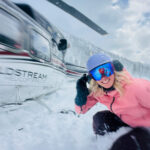Aside from better equipment, speed is a fundamental problem we’ve created since good grooming began in the ’80s
It was too icy for Martin Olson, Ski Canada’s technical editor emeritus, to go back out after lunch the other day, and since my back was starting to turn into a question mark from too much time hunched over the computer, we had a long-needed catch-up call. One of our rants quickly ensued, this time about speed.
“Skiing, driving, living…life is just too fast these days,” said Olson definitively. “And that’s the problem with the world today: speed. Well, speed—and Facebook.”

The conversation’s levity stopped abruptly, though, when I brought up the horrifically sad news of a little British girl who died on a beginner run at Flaine in the French Alps in mid-January. In a Saturday-morning class with four other innocents led by their ski instructor, five-year-old Ophelie was hit by a skier in a rush. Despite his best efforts at resuscitating her (the skier just happened to be a volunteer firefighter), she died in the helicopter.
After an initial investigation, the unnamed 40-year-old local skier was first “placed under judicial control,” said Public Prosecutor Karline Bouisset, and later charged with manslaughter. “The child was in a single file behind the group and was about to make a right turn when she was very violently hit by the skier arriving at high speed, who tried in vain to avoid her,” wrote Bouisset.
I later had a long chat with Ryan Morasiewicz, a Vancouver-based Manning Park skier, young father and expert in civil liability law. Too long and complicated to summarize in the space available here, we’re going to have to return to this related subject in an issue next autumn.
Meanwhile, with pangs of guilt, how many of us could see ourselves in the role of the speeding skier? It’s time for lunch, you’re the last one in the group (or maybe the first?), it’s the end of the day…it’s easy (sometimes even necessary) to let off the brakes on that nice flat groomer on your way back to the lodge or parking lot. And sometimes you’re weaving between slower skiers.
“When most of us see flats ahead, our reaction is to keep the speed up and go faster,” said Olson. With an inherent blind spot, “snowboarders in particular need extra speed before flats if they want to avoid stopping and walking.” Now add a weaving S of skiing ducklings into this shooting-gallery scene.
“Slow signs don’t do anything,” said Olson cynically. “The only way to slow people down is to install a chicane, but that only works in a narrow choke point on a slope.”
Olson agreed with me: aside from better equipment, speed is a fundamental problem we’ve created since good grooming began in the ’80s—and that means making a carpet-like surface.
“The better the grooming, the faster we ski. And I think some people probably feel safer at speed now that most of us are wearing a helmet,” said Olson. “No one could ski the speeds we do now when hills were full of moguls and grooming was so rudimentary.”
About a week after the death in Flaine, in another French resort, La Rosière, 37-year-old film star, Chanel model and expert skier Gaspard Ulliel, whom French President Emmanuel Macron called “an icon of French elegance,” died in a collision with a snowboarder on a beginner run.
Ulliel died of a massive head injury at the University of Grenoble Hospital where Ophelie was headed. And where eight years ago Michael Schumacher (wearing a helmet) was treated after hitting a rock, in what was described as a barely moving slow speed.
The scenario in Ulliel’s case sounded like two merging slopes, where in the Alps minimal signage along with minimal skier and snowboarder awareness of others are involved. Albertville Prosecutor Anne Gaches said in a statement, “He had just branched off to the left, presumably to join his friends.”
Although it happens everywhere, the sudden decision to turn across a slope without checking first to see if there’s oncoming traffic is much more common in the Alps than Canada, and the resulting collisions are magnified by speed.
With this inherent risk of our sport, at the minimum we can only slow down, be hyper-aware of others—and assume others around us are oblivious.



